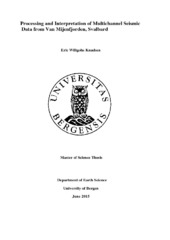| dc.description.abstract | This work was done based on 10 multichannel seismic lines from Van Mijenfjorden, collected during Svalex in 2013 and 2014-. The objective of the thesis is twofold: 1. In the first part processing is done where emphasis has been in removing multiples and noise from the data. 2. Interpretation of the data is done in the second part. Here identification of seismic structures as well as correlation with the Ishøgda well is done. A problem in the processing are high velocities in seabed and shallow water depth, which causes strong multiples. Multiple removals were performed by applying deconvolution and f-k filtering. Velocity filtering is performed on the CDP position of both shot and receiver collection. This allows the collections that are shot in opposite direction to be simulated. Collections shot in opposite directions will have different apparent velocity since they are shot either "up-dip" or "down-dip". Furthermore, surface consistent deconvolution was used to attenuate remaining multiples after f-k filtering. This process computes a filter for shot, receiver position and offset In addition different modules are used for improving signal to noise ratio, amplitude recovery, amplitude smoothing and spherical spreading correction etc. The data is interpreted based on data from the Ishøgda well, which was drilled in 1965-66. The well is located 77◦50’22’’N, 15◦58’00’’E and reaches down to Lower Permian. The reflectors under Van Mijenfjorden depict a wide, asymmetric syncline,-(the central Spitsbergen Basin) which has deposits of Tertiary age. Upper Cretaceous rocks are missing on Svalbard; which makes base Tertiary an unconformity. The underlying formation within the Lower Cretaceous has thickness estimates near the thickness of the same formations adjacent to the fjord. Within the Janusfjellet subgroup there exists large thickness variations, which is caused by folding and is related to the Tertiary compressional tectonics. There exists small anticline structures in the syncline, which is likely caused by mobilization of the shales from the Agardfjellet formation (Upper Jurassic). A reflector in middle Triassic at ca 1400 ms stands out as the strongest amplitude in the seismic. This reflector is interpreted to be a dolerite. It is also very likely that there exists a dolerite in the Kapp Toscana formation. The depth of the Permian /Triassic boundary is found to be at approximately 3.8 km depth and corresponds to an impedance contrast between the highly silicified carbonates of the Kapp Starostin Formation and overlying shales in the Sassendalen formation. An unconformity is interpreted at 2200 ms twt and is thought to represent an unconformity at base Gipsdalen. Furthermore, the top of the Hecla Hoek is interpreted to be located at 2800 ms twt because it represents the strongest reflector under 1400 ms twt. Below this depth, reflectors have much higher dips and do not follow the geometries of above lying reflectors.The area in the western part of the seismic is part of the West Spitsbergen Fold and Thrust belt. This is an area hard to migrate because the area constitutes complex structures. However a rough interpretation of the area is done and asymmetrical folds is interpreted in the area. Further north in Van Mijenfjorden more symmetrical folds are found, a reason for this could be that the stress induced into this area was lower. These structures most likely formed in response to the opening in the North Atlantic Ocean. No normal faults are interpreted in the area. Such faults could exist due to the spreading of Oligocene seafloor between Greenland and Svalbard causing oblique extension. | en_US |
